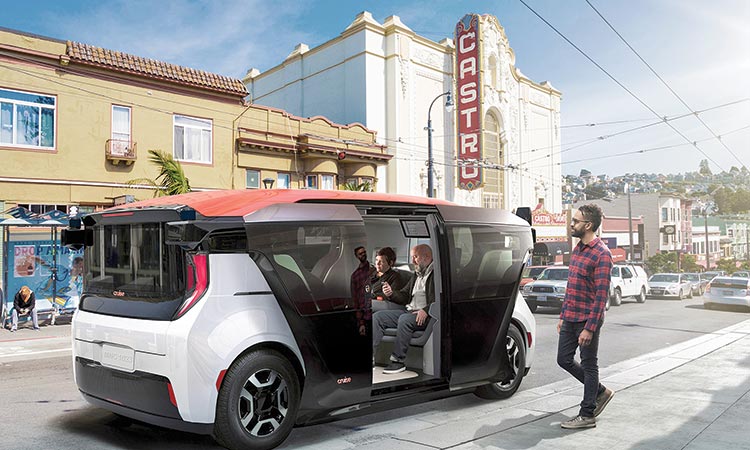GM’s Cruise unveils driverless e-vehicle for ride sharing use

General Motors’ ‘Cruise Origin’ during the unveiling ceremony in San Francisco. Associated Press
General Motors’ self-driving car unit, Cruise, on Tuesday unveiled a prototype electric vehicle with no steering wheel or pedals for use in its planned autonomous ride-sharing service.
The vehicle, named ‘Cruise Origin’, was developed with Honda Motor, which took a minority stake in Cruise in 2018 in an effort to catch up with rivals in developing a technology with enormous costs and risk and no market-ready products.
While car makers across the world are racing to develop self-driving vehicles, the technology has yet to gain widespread consumer acceptance as recent accidents involving such vehicles raised doubts about its readiness for public roads.
Cruise’s Chief Executive Officer Dan Ammann said the boxy vehicle about the size of a large SUV with sliding doors on each side will be used for the company’s own ride-hailing service, but did not say when the new competitor to Lyft and Uber Technologies would launch.
Cruise was valued at $19 billion in May. In July, it delayed plans to launch a commercial robo-taxi service by the end of 2019, and still does not have a permit from California regulators to test self-driving cars without a safety driver. Alphabet’s Waymo is the only company that has received permission to test without a driver.
“We’re obviously still working on something that’s never been done before. So the time lines given aren’t completely certain, but we’re moving really quickly,” Ammann told reporters following the event.
Cruise operates a ride service for its employees in San Francisco that have self-driving cars with safety drivers behind the wheel. Most of Cruise’s 180 test cars operate in the city, and Ammann said they could be used to start a commercial ride-sharing service before the driverless prototype vehicle is ready.
While Ammann said the Cruise Origin was a “fully engineered vehicle that’s on its way to production,” he said he was still talking to the National Highway Traffic Safety Administration for a waiver to be able to deploy vehicles without human controls on the roads.
He expects prototypes to be tested at private facilities this year and forecast the production cost of an Origin could be half that of a high-end electric sports-utility vehicle (SUV).
Details about where the prototype will be manufactured will come in the next few days, Ammann said.
Cruise is not the only company to propose using vehicles without human controls, and companies such as Navya and May Mobility have developed vehicles that can be used for ride sharing.
The service still being developed by GM’s Cruise subsidiary will rely on a boxy, electric-powered vehicle called “Origin” that was unveiled late Tuesday in San Francisco amid much fanfare.
It looks like a cross between a mini-van and sports utility vehicle with one huge exception - it won’t have any steering wheel or brakes. The Origin will accommodate up to four passengers at a time, although a single customer will be able summon it for a ride just as people already can ask for a car with a human behind the wheel from Uber or Lyft.
For all the hype surrounding the Origin’s unveiling, Cruise omitted some key details, including when its ride-hailing service will be available and how many of the vehicles will be in its fleet. The company indicated it will initially only be available in San Francisco, where Cruise has already been offering a ride-hailing service that’s only available to its roughly 1,000 employees.
By eliminating the need for a human to drive, Cruise theoretically will be able to offer a less expensive way to get around - a goal already being pursued by self-driving car pioneer Waymo, a Google spinoff that has been testing robotaxis in the Phoenix area for nearly three years.
Cruise had planned to have a robotaxi service consisting of Chevrolet Bolts working without human backup drivers by the end of 2019, but moved away from that last year after one of Uber’s autonomous test vehicles ran down and killed a pedestrian in the Phoenix suburb of Tempe, Arizona, during 2018.
Still aware of the fallout from that deadly crash, Cruise is promising “superhuman performance” from the Cruise, which GM hopes to manufacture at half the price of comparable vehicles using fuel-combustion engines. GM also expects to announce where the Origin will be made within the next few weeks, Cruise CEO Dan Amman said.
Agencies



